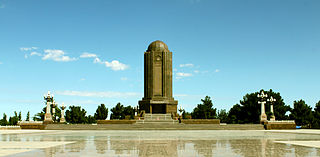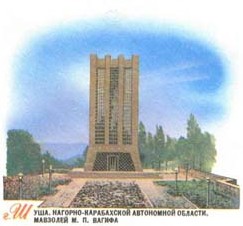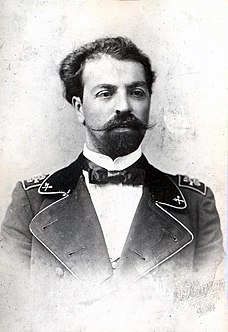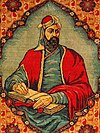
The Nizami Mausoleum, built in honor of the 12th-century Persian poet Nizami Ganjavi, stands just outside the city of Ganja, Azerbaijan. The mausoleum was originally built in 1947 in place of an old collapsed mausoleum, and rebuilt in its present form in 1991.

The National museum of Azerbaijan literature named after Nizami Ganjavi - was established in 1939, in Baku. It is located in the centre of the capital of Azerbaijan, not far from the Fountains Square and near the entrance of Icheri Sheher. Now this museum is one of the greatest and richest treasuries of Azerbaijani culture.

Fuad Hasan oglu Abdurahmanov was a popular Azerbaijani monument sculptor. He received many awards, including: Honored Worker of Arts of the Azerbaijan SSR (1943), People's Artist of the Azerbaijan SSR (1955), the first Azerbaijani to become a corresponding member of the Academy of Arts of the USSR (1949), and Laureate of the State Stalin Prize two times.

Vagif Mausoleum was built in honor of Molla Panah Vagif, a poet, prominent statesman and diplomat and vizier - the foreign minister of the Karabakh Khanate.

Nizami Street is a large pedestrian and shopping street in downtown Baku, Azerbaijan, named after classical poet Nizami Ganjavi.

Zivar bey Garay bey oglu Ahmadbeyov - the first Azerbaijani architect with higher education.

The Monument to Nizami Ganjavi, a medieval Persian poet, is located in Baku in Nizami Square, on the intersection of Istiglaliyyat, Ahmad Javad, Azerbaijan and Islam Safarli streets. The opening ceremony of the monument was held in April, 1949. Sculptor of the monument was Fuad Abdurahmanov - People’s Artist of Azerbaijan.

Heydar Aliyev's cult of personality, also known as Heydarism, became a significant part of Azerbaijani politics and society after he came to power in 1993 and continuing after his death in 2003, when his son Ilham Aliyev succeeded him. Aliyev, a former Soviet politburo member and the leader of Soviet Azerbaijan from 1969 to 1987, became the President of Azerbaijan in 1993. He then began to carefully design an autocratic system, with heavy reliance on family and clan members, oil revenues and patronage.
The Monument to Nizami Ganjavi in Saint Petersburg is located in a square situated between houses 25 and 27 on Kamennoostrovsky Prospekt.
The Monument to Nizami Ganjavi, the medieval Persian poet, is located in the capital of Italy, Rome, in Villa Borghese gardens, on Viale Madama Letizia Street. Salhab Mammadov, People’s Artist of Azerbaijan and Ali Ibadullayev, Honoured Artist of Azerbaijan are the authors of the monument. The Commission on History and Arts of Rome approved the project.
The Monument to Nizami Ganjavi, a medieval Persian poet, is located in Chaoyang Park, in Beijing, China. Yuan Xikun, a Chinese artist, is the author of the monument.
The Monument to Nizami Ganjavi, a medieval Persian poet, is located in Tashkent, the capital of Uzbekistan, in a square near the Tashkent State Pedagogic University named after Nizami, near a park named after Babur. Ilham Jabbarov is the sculptor of the monument.
The Khojaly Genocide Memorial in Khatai raion, Baku, and the first public memorial in Azerbaijan dedicated to victims of the Khojaly Massacre.
The monument to Nizami Ganjavi is a monument to the outstanding poet Nizami Ganjavi, located in the hometown of the poet, Ganja, Azerbaijan. The monument was erected in 1946.
Multiculturalism -is directed to protect differentiation of cultures of people from different nationalities and religions from whole world, integrate national culture of minor nations and countries.
A statue of medieval Azerbaijani poet, writer and thinker Fuzûlî forms a major monument in the city of Baku. The statue was prepared by Azerbaijani sculptors Tokay Mammadov and Omar Eldarov between 1958 and1963. The architect of the statue is Haji Mukhtarov.

Gold medal named after Nizami Ganjavi is a state award of Azerbaijan. On May 16, 2014, it is established by National Assembly of Azerbaijan and awarded annually to Azerbaijani scientists and a foreigner scientist for their remarkable scientific works.

January 20 is a monument complex located in the city of Baku, Azerbaijan. İt was built in memory of the victims of January 20, 1990. The monument was erected on the territory of the Yasamal district, near the "January 20" ring road.














